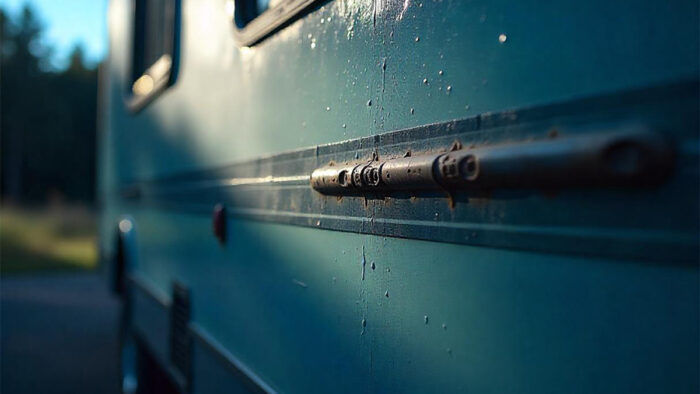RV insurance typically does not cover delamination repairs owing to the fact that it is mostly caused by negligence and lack of maintenance.

Delamination happens when the layers of an RV’s exterior separate, and if not addressed right away, it can cause serious harm to the vehicle. The laws that protect these vehicles are always changing along with the RV sector.
Most insurance companies view delamination as a preventable issue, and because of this, the cost of repairs will not be covered. In essence, RV insurance will not pay for the cost associated with delamination repairs because proper maintenance could have prevented it.
Nevertheless, it is entirely possible to prevent delamination once you notice the signs, and this can only be done through regular maintenance. RV owners are strongly advised to inspect their vehicle regularly and reseal the seams if they notice any crack whatsoever. Through proper immanence, you can prevent delamination and protect your financial interests along the line.
What Is Delamination?
Delamination is typically when the layers of material break or peel off, and it often occurs in composite structures like those found in recreational vehicles (RVs). Delamination usually affects the external walls of RVs, which are made of layers of insulation, wood, and fiberglass. A number of things, such as water ingress, extended sun exposure, and poor maintenance, can lead to this separation.
Moisture can cause noticeable bubbles, blisters, or soft areas on the surface by weakening the adhesive bonds holding the layers together. Overall, delamination can cause serious structural damage if left unchecked, which can ultimately compromise the RV’s worth.
What Causes RV Delamination?
Delamination occurs due to several reasons, and we will be examining four of them in this section:
- Neglect: Negligence is one of the major reasons why delamination occurs. If you don’t pay proper attention to the structures of your RV, you won’t easily notice the signs of delamination. Most vehicle owners regularly inspect tire pressure and oil level but end up neglecting the structures of their car. Acts of negligence and lack of maintenance can cause delamination.
- Water: This is also one of the primary causes of delamination in RVs. Water can seep into the composite elements of an RV when it gets beyond the outer layers, which is often the result of leaks from broken windows, roofing, or seals. Over time, the layers separate as a result of the moisture weakening the adhesive connections holding them together. In addition to compromising the RV’s structural integrity, the presence of water exacerbates the delamination process by enabling an environment that is favorable to mold and rot.
- Manufacturer Defects: Delamination in RVs can also be caused by the manufacturer’s flaws. These defects can be as a result of poor building materials, insufficient bonding agents, or faulty construction methods. The bonds may break under stress or as a result of environmental conditions if the adhesives used to laminate the layers are poor quality or applied incorrectly. Furthermore, materials may deteriorate more quickly and separate if they are not made to endure the demands of RV use.
- Normal Wear and Tear: A natural phenomenon that can also affect the worth of your RV is wear and tear. Small cracks can appear in the body of your RV when you’re flexing some of its structures. However, if the crack is addressed urgently, it won’t pose a significant issue.
What Are The Common Signs Of Delamination?
Perhaps you are wondering if you’ll ever know when delamination occurs. Here are typical signs that show a high chance of RV delamination:
- Cracks
- Tears
- Spongy areas
- Unusual sounds when tapping on surfaces
- Bubbles or blisters
- Creases
- Water damage or stains
- Odor of model
- Visible separation of layers
If you notice any of these in your RV, it is an indicator of delamination, and you need to take action to prevent it from turning into a bigger issue.
How to Prevent RV Delamination
If you notice delamination on your recreational vehicle, we have some useful tips for you. Since RV insurance typically does not provide coverage for delamination repairs, here’s what to do:
- Find and seal the leak.
- Ensure you clean all seals before sealing it back.
- Check the inside of your vehicle for any type of mold or damage.
- Check the roof and aides of your RV for potential damage.
- Avoid overloading your RV.
- Limit sun exposure.
Most importantly, always conduct regular maintenance checks to avoid having to pay out of pocket for delamination repairs. By conducting regular maintenance checks, you will be able to detect the issue faster and manage the situation before it gets out of hand. If after trying out these tips, the situation is still out of hand, you can reach out to a professional.
Conclusion
Having established that RV insurance does not cover delamination repairs, it is important to have a full understanding of your policy. To be sure you are adequately protected against other types of risks and perils, you can reach out to your insurance company for clarifications. Don’t forget that you can prevent delamination by taking proper care of your vehicle.



